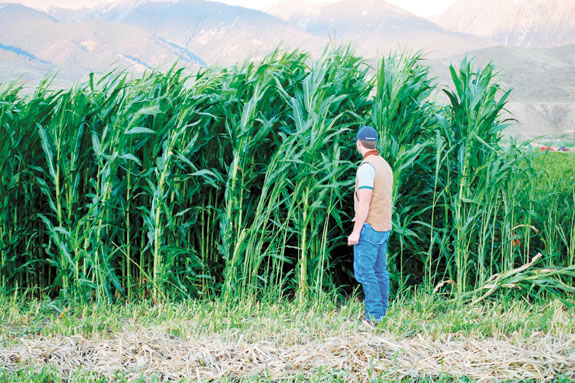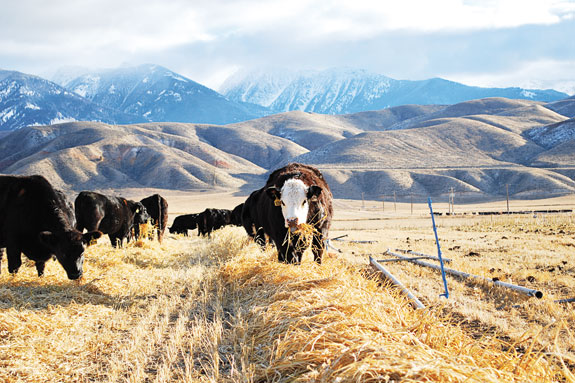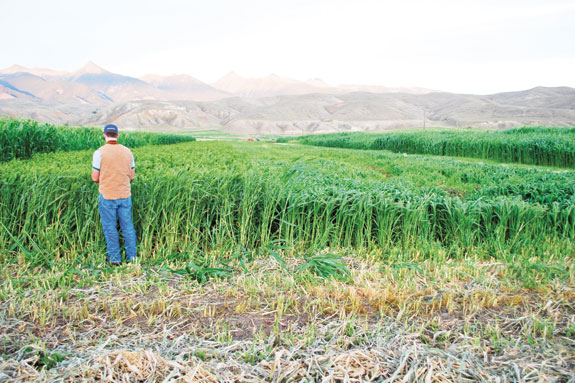In dry climates, ranchers often run short of late summer and fall pasture, especially when productivity of cool-season perennial grasses is limited during the heat of summer.
In 2008, the University of Idaho’s Nancy Cummings Research, Extension and Education Center began looking at ways to extend grazing with use of summer annuals.
“We looked at species that grow well in dry corners of pivot-irrigated ground to increase hay yield or pasture,” says John Hall, extension beef specialist.
“This evolved into a project to increase forage production for fall grazing or when renovating a hayfield.”
Test plots were continued for three years, 2008 through 2010. “Last year, production was a little lower, and we felt this was due to the cooler summer,” says Hall.
When irrigation was available during the 60-day growing season the first year, some species produced two to three tons to the acre.
Part of the plot was given only a month of irrigation, with water turned off August 1, to simulate what happens on many ranches when water is no longer available.
The first test plots contained five species of warm-season annuals: sudex, teff (a grass produced in Idaho),

German foxtail millet, pearl millet and grazing corn, planted July 1. Production varied from 0.5 tons per acre for pearl millet with no irrigation after early August to 5.6 tons per acre for sudex (sorghum-sudan grasses) with full-season irrigation.
The most promising species that year, according to Hall, were sudex, German foxtail millet and teff. They all produced more than 2.5 tons per acre in less than 60 days.
The next two years the entire plot was irrigated. The same species were planted but with a change from grazing corn to a short-season silage corn.
“The grazing corn put out more tillers, but in subsequent years we used silage corn because we got more tonnage. We also used white proso millet,” says Hall.
All three years, the plots were planted July 1 – a late-season planting. “Part of the reason for planting that late was to avoid possibility of frost, and as we got farther into the project we felt one of the uses for this grazing strategy would be to renovate a hayfield,” he says.
The second year, they harvested first cutting on an alfalfa field they planned to renovate and then used no-till planting of summer annuals for late-season grazing.
“We sprayed the field to kill the old alfalfa and then planted annuals. This works nicely if you want to avoid auto-toxicity problems (mature alfalfa plants produce a toxin that kills new alfalfa seedlings) when following alfalfa with alfalfa.
We kill what’s left of the alfalfa and then no-till plant the annuals. If needed, you could use additional herbicides to control alfalfa while annuals are growing.
Then the next spring when you’re ready to work the ground, it’s cleaned up better, making better conditions for the next seeding of alfalfa – while still providing fall grazing,” says Hall.

“Another use for summer annuals would be on dedicated acres. Timing of planting would depend on your grazing needs.
Some of the annuals we put in for fall grazing, if planted earlier, could be grazed once and left to grow again for fall. This would depend on the length of your growing season,” he says.
“One of our reasons for planting late (since we planned to graze once, in the fall) is that these plants hit the physiological stage where they provide maximum yield and still have good nutrient quality for fall grazing.
For example, corn is usually producing tassels and silk by then, but not much grain formation. The sudex has headed out but is not mature – and the same with most of the other species.”
The frost hits it at that stage and it doesn’t become overly mature.
“With corn, instead of grazing corn stalks, you are grazing frosted standing corn, with more nutrients in the total plant.
Over the three years, the nutrient analyses we’ve done – with frost hitting these plants at their maximum growth stage but before they become overmature – crude protein levels have been between 9 and 10 percent on the low side, and on the high side, between 13 and 14 percent.
The energy values also exceed what a dry cow would need after weaning her calf,” says Hall.
This would be ideal grazing for young cows or any cows that lost body condition while raising calves through the summer. “This is something we can graze without any need for supplementation,” he says.
“We found that our top-yielding species was corn, if we could get it planted properly. That was one of our frustrations until recently, because we didn’t have a corn planter.
The other species are easier to plant. Many people have access to a no-till drill, which can be used for the sudex or German foxtail millet,” says Hall.
“Sorghum sudan grass was a close second to corn, for top production, followed by German foxtail millet – another good performer.
These are all excellent species, if you plan to graze them once. If you have opportunity to graze twice, you can use teff. It produces a crop so quickly that you can graze it several times.

We had to take a hay crop off because it grew so fast, and then we got some regrowth for fall grazing. For what we were actually trying to do (provide fall grazing), the teff didn’t work as well because we had to cut it,” he explains.
It does produce good hay, however. “It’s a lot like timothy hay, except it’s just a little lower in protein. It makes good horse hay. It’s very fine-stemmed, with fine leaves, and quite palatable.
It’s not high in energy, which is fine for adult horses – especially if they’re not working hard. If you plant it early, it could be grazed several times during a growing season.
It does require a prepared seedbed, however. This is the only species we didn’t no-till. But we just disked the ground a couple times and used a Brillion grass seeder,” says Hall.
Over the three-year project, corn produced between three and five tons per acre. “The variation was related to our ability to get it planted properly.
The sudex was very consistent at about 3.5 tons per acre. The German foxtail millet was between 2.5 and three tons per acre, under irrigation.
The nice thing about German foxtail millet is that ranchers in Wyoming and Montana use it on totally dry land and get about one to 1.5 tons per acre – in country that gets about 14 inches of annual precipitation.
Actual production may depend on pattern of rainfall during summer, however,” he says.
“We followed the normal seeding rate on all species and strip grazed in the fall. On the sudex and the corn we got about 70 animal grazing days per acre.
The German foxtail millet gave us about 60 animal grazing days per acre. We grazed these plots in the fall, with heifers,” he says.
“We learned that sudex and corn work very well if you want to graze after snowfall. They stand up and the cattle can get to it and root it out of the snow.”
If you plan to graze the other species after snow, you might have to put it in windrows, at more cost.
“If it’s just a light snow, cattle continue to graze the millets, but these mash down in a heavy, wet snow.
As long as it doesn’t crust over, cows will dig for it, if they know it’s there, but sudex and corn worked a lot better because there was always something sticking up for cows to grab and pull out of the snow.
We grazed a lot of that in December,” says Hall.
One drawback to annuals is that wildlife are attracted to them. “Deer hit us hard last year. Any time we extend grazing late in the season in this part of the country, deer and elk come into it.
They didn’t seem to bother the sudex as much as they did the corn.” ![]()
PHOTOS
PHOTO 1 The test plots included a strip of grazing corn.
PHOTO 2: The silage corn produced more tonnage per acre than the grazing corn.
PHOTO 3:Heifers grazing the test plots in late fall.
PHOTO 4 Checking one of the test plots. Photos courtesy of University of Idaho Nancy Cummings Research Center.








